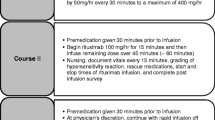Abstract
Goals of work
Targeted monoclonal antibodies (MoAbs) have become a promising treatment option for patients with cancer. However, there is a risk of developing infusion reactions (IRs) with MoAbs. This study was conducted to evaluate the impact of IRs on staff time and costs among patients receiving an initial infusion of cetuximab (Erbitux®) and rituximab (Rituxan®).
Patients and methods
A prospective multicenter study involving time and motion and activity sampling methods was conducted among patients with cancer receiving their first outpatient infusion of cetuximab or rituximab. Patients were observed from initiation of MoAb infusion to the end of the clinic visit. IRs were classified as absent, mild/moderate, and severe/life threatening. Staff time and costs were estimated for preparation and administration of MoAb, other chemotherapy agents, and for management of IRs. Resource costs were compared across IR groups within each MoAb.
Main results
Among 161 patients enrolled, 32% of 71 patients on cetuximab and 39% of 90 patients on rituximab experienced IRs. Treatment of patients who experienced IRs required more staff time (31–80% more time) and resulted in higher human resource costs (increase of 17–65 US dollars) than patients who did not experience IRs.
Conclusions
IRs following cetuximab and rituximab administration are common and are associated with measurably increased costs of care. The frequency of IRs suggests the importance of identifying clinical guidelines for intervention and management.


Similar content being viewed by others
References
Bernier J (2006) Cetuximab in the treatment of head and neck cancer. Expert Rev Anticancer Ther 6:1539–1552. doi:10.1586/14737140.6.11.1539
Cersosimo RJ (2003) Monoclonal antibodies in the treatment of cancer, part 2. Am J Health Syst Pharm 60:1631–1641, quiz 42–43.
Cersosimo RJ (2003) Monoclonal antibodies in the treatment of cancer, part 1. Am J Health Syst Pharm 60:1531–1548.
Chung CH, Mirakhur B, Chan E, Le QT, Berlin J, Morse M (2008) Cetuximab-induced anaphylaxis and IgE specific for galactose-alpha-1,3-galactose. N Engl J Med 358:1109–1117. doi:10.1056/NEJMoa074943
Fortner BV, Tauer K, Zhu L, Okon TA, Moore K, Templeton D et al (2004) Medical visits for chemotherapy and chemotherapy-induced neutropenia: a survey of the impact on patient time and activities. BMC Cancer 4:22. doi:10.1186/1471-2407-4-22
Genetech (2005). Drug label for rituxan, vol 2007. Genetech
Green SBAU, McCoy JF, Burns KP, Smith AC (1982) Accuracy of observational data with whole interval, partial interval, and momentary time-sampling recording techniques. J Behav Assess 4:103–118 doi:10.1007/BF01321385
ImClone and Bristol-Myers Squibb (2005) ImClone and Bristol-Myers Squibb Erbitux drug label, vol 2007. ImClone and Bristol-Myers Squibb, Princeton, NJ
Kohler G, Milstein C (2005) Continuous cultures of fused cells secreting antibody of predefined specificity. 1975. J Immunol 174:2453–2455.
National Cancer Institute (2003) Common terminology criteria for adverse events v3.0 (ctc). National Cancer Institute, Oxford
Pelletier D, Duffield C (2003) Work sampling: valuable methodology to define nursing practice patterns. Nurs Health Sci 5:31–38. doi:10.1046/j.1442-2018.2003.00132.x
Plosker GL, Figgitt DP (2003) Rituximab: a review of its use in non-Hodgkin's lymphoma and chronic lymphocytic leukaemia. Drugs 63:803–843. doi:10.2165/00003495-200363080-00005
Rajpal S, Venook AP (2006) Targeted therapy in colorectal cancer. Clin Adv Hematol Oncol 4:124–132.
Thomas M (2005) Cetuximab: adverse event profile and recommendations for toxicity management. Clin J Oncol Nurs 9:332–338. doi:10.1188/05.CJON.332-338
Vizcarra C, Belcher D (2006) Management of the patient receiving parenteral biologic therapy. J Infus Nurs 29:63–71. doi:10.1097/00129804-200603000-00003
Wong SF (2005) Cetuximab: an epidermal growth factor receptor monoclonal antibody for the treatment of colorectal cancer. Clin Ther 27:684–694. doi:10.1016/j.clinthera.2005.06.003
Author information
Authors and Affiliations
Corresponding author
Additional information
This work was supported by funding from Amgen Inc.
Rights and permissions
About this article
Cite this article
Schwartzberg, L.S., Stepanski, E.J., Walker, M.S. et al. Implications of IV monoclonal antibody infusion reaction for the patient, caregiver, and practice: results of a multicenter study. Support Care Cancer 17, 91–98 (2009). https://doi.org/10.1007/s00520-008-0474-5
Received:
Accepted:
Published:
Issue Date:
DOI: https://doi.org/10.1007/s00520-008-0474-5




